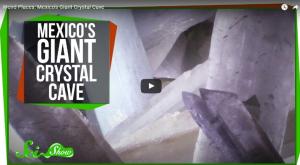What's In The Mineral
Before we begin discussing minerals and crystals, let's take a look at actual silver crystal growth in real-time.
We are going to actually watch silver crystals grow in real-time in a microscope.
- You will need microscopes for each group of students.
- Cut 1 inch of copper wire and place it on a Petri dish under the microscope.
- Add two drops of silver nitrate to the copper.
- Observe the results. Try observing using two different magnifications.
If you missed this demonstration you can watch the following video.
Minerals can be made out of the same element or they can be made out of multiple elements that have atomically bonded together.
Minerals form in a few different ways.
- Minerals can form from magma/lava as it cools. The slower it cools the more time a mineral has to crystallize and therefore the larger the mineral crystals can grow. An example would be granite vs. basalt. Granite cools off inside the Earth's crust and has a relatively long cooling period. Basalt, on the other hand, cools off quickly as lava runs on the surface of the Earth.
|
|
|
- Minerals can form from elements that are found in liquids. One method of forming minerals is called precipitation and the mineral is considered to be an evaporite. Evaporites occur when liquids evaporate precipitating elements and atoms that begin to bond-forming elements which in turn form mineral crystals. Evaporites are commonly found in ancient lakes and seabeds. Halite and gypsum are examples of evaporites.
Given enough time and plenty of space to grow, minerals can get really, really big. Check out this cave that was found in Mexico.
98% of the Earth's crust is made of only 8 elements. However, by combining those elements together in different combinations, you end up with 4000 minerals. Still, there are really a few dozen minerals that are common. Most of the common minerals are in a group called silicates because they contain silicon and oxygen as well as one or more other elements. The elements that pop up on the Earth the most are Oxygen, Silicon, Aluminum, Iron, Calcium, Sodium, Potassium, and Magnesium. If Mother Nature combines Iron, Oxygen, and Hydrogen together in just the right amount you might get Limonite. Think of these elements as ingredients to cooking up minerals.
There are going to be two other activities that we are going to do.
1. Let's make our own Salt Crystals and see if we can combine the elements of Sodium and Chloride together to create an evaporite.
- Salt Crystal Lab for Snowflake HS, Holbrook HS, and Heber HS students
- You can purchase this lab at Teachers Pay Teacher for $0.80 cents.
3. Let's take a few common minerals and break them down into their individual elements to see what ingredients Mother Nature used.
- What's in That Mineral worksheet? This one is for my students.
- If you are not a student you can purchase this activity on Teachers Pay Teachers for $1.00.















